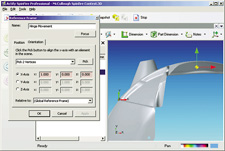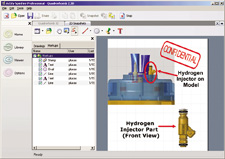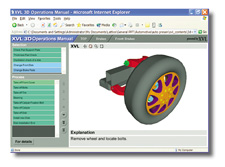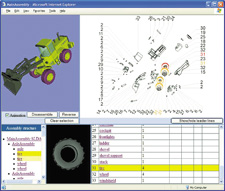Reaching Past V&M for Effective Collaboration
Tools from Actify and Lattice3D satisfy varied data sharing needs from molding machine covers to maintaining space shuttle design criteria.
Latest News
August 1, 2004
By Louise Elliott
Spinfire products from Actify, Inc. and Lattice3D tools from Lattice Technologies USA, Inc. both fit into a broad category of visualization and markup (V&M)—the most widely used category of collaborative technologies. However, the two sets of tools serve different, though somewhat overlapping, markets, and satisfy a wide range of data-sharing and collaborative needs. Actify’s products address the needs of the design community primarily, while Lattice tools offer standards-based support from engineering to downline applications and users.
Designers TargetedActify focuses on providing 3D CAD V&M (it now also supports 2D) for virtually all CAD programs with its Spinfire Professional, a system that converts native files to its own .3D format for viewing. Randy Ochs, Actify CEO, says the company’s products are designed for “users in discrete manufacturing—automotive, aerospace, industrial automation, and consumer goods.”
Earlier this year, Actify launched Spinfire 2004, which includes a .3D workspace to enable non-CAD data, such as manufacturing specifications in Word, BOMs in Excel, and other frequently used formats to be embedded and accessed via tabs on the screen. Spinfire also enables digital mockup of assemblies containing parts and subassemblies created in different CAD programs.
Figure 1: SpinFire 2004’s .3D WorkSpace of an 8-cylinder Nitrogen-fired engine shows how the feature lets users organize all related documentation (specifications, BOMs, 2D drawing, 3D models, etc.) in a single .3D file. | Figure 2: Actify users can position a local coordinate system anywhere in a 3D model for sophisticated measuring and analysis (i.e., determining angles between converging faces), and easily reposition and align subassemblies. |
Lattice3D aims at a broader market. Its hallmark is a trademarked language called XVL (eXtensible Virtual world description Language). Written in
“XVL can take a 15GB CAD file, for example, reduce it to 15MB, and open it in 20 seconds,” says company President and CEO Alexander Garcia-Tobar.
SpinFire Professional’s new 2D snap shot feature and upgraded 2D viewer component means the user can freeze a view of a 3D model in order to focus in and communicate specific details of the model. These 2D snap shots will remain connected to the 3D model, and can be automatically updated if the 3D model changes. |
Lattice3D incorporates visual and nonvisual information so that it can be used for 3D Web publishing of such documents as online manuals. Its intention is, in Garcia-Tobar’s words, “to leverage 3D assets across the enterprise and use the data for many purposes additional to engineering.”
For example, Lattice3D can associate engineering files—CAD and CAE—with documents such as BOMs and materials lists. It can produce assembly manuals for manufacturing with exploded views for shop-floor product assembling. It has also been used for part procurement, parts lists that can be shared, 2D and 3D illustrations, and customer support. The format makes it possible for users to obtain tolerance and interference information, see general defects in design, and create and e-mail tolerance maps for manufacturing. This month, the company launches a new, general-purpose interface for all Lattice 3D applications.
Spinfire In Real LifeVincent Mortlock, commercial manager for Broadwater Moulding Ltd., in Suffolk, England, was the manager for a project during which the company created glass-reinforced plastic molds for the cover of a machine used for medical purposes.
“The machine part had an estimated three-year lifespan,” Mortlock says. Until this job, the company had used manual drawings to create wood patterns for the molds. “Our customers wanted to design a new machine from scratch. They had just started to use 3D CAD (Pro/Engineer) and wanted the exterior covers to be converted to CAD to help them design a better surface.”
Broadwater Moulding didn’t have its own CAD program and the company wanted a system that would help it react quickly to customer changes and requests. “We found Spinfire and tried it,” says Mortlock. “It proved to be able to take in the CAD model, allow us to take measurements and annotate models, and helped us deal with many quick design changes.”
The company subsequently purchased a seat of Pro/Engineer, but still uses Spinfire Professional. According to Mortlock, “We can view data as it arrives, and both dimension and section it to see how parts go together. Our only problem, until the 2004 version, was being unable to assemble in Spinfire. We’re looking forward to being able to do that once we implement the new version. Spinfire tools really help us to speed up our work, because we can do so many iterations in a short time, working closely with the customer.”
Another mold-making company, Delta Technologies Group located in Auburn Hills, Michigan, which also makes manufacturing tools, has used Spinfire for about five years. Tibor Toreki, vice president of the company’s advanced technology division, says, “The new Workspace gives us additional information, especially information that’s needed on the shop floor, in a single environment that makes it possible to conduct reviews with customers.”
He has done collaborative work in the past, using other tools, and believes that the Spinfire 2004 release will take no more than a month for everyone to learn to use. “It’s a very clean process, and Actify seems to be trying to provide what we really need and want.”
Lattice3D applications allows for rapid creation of a 3D manual for a major automotive organization showing after-market training instructions to change front brakes. This manual is available online in an interactive format to allow availability and ease-of-use for the technicians. | This instant 2D/3D parts list for a motorcycle clutch assembly was created within Lattice3D applications by taking information rapidly from 3D data and putting it directly on a browser. The automated creation process attaches part numbers to each part, and includes PDM data (with a “magnifying glass” effect to allow viewing of each discrete part as it is clicked). These parts lists are best created and used online for use throughout an enterprise. | ||
Julian Gomez, Ph.D., is a senior scientist for the Research Institute for Advanced Computer Science, one of two groups in the University Space Research Association, working at the NASA Ames Research Center in Moffett Field, California, on the digital shuttle project. The objective of the project is to collect all 3D CAD data associated with the space shuttle, standardize it, and make it useable at the various NASA centers.
Gomez says that he became interested in Lattice3D’s high compression capabilities, CAD independence, and support for ISO standards—and believes that those capabilities will make collaboration and funneling data easier and faster, and keep it very accurate. “There isn’t very much CAD available of the shuttle right now, but among the recommendations after the Columbia disaster studies was one stating that 3D CAD models are necessary for safety,” he says. “I wanted ways to visualize those models without all the engineering data that makes such files so big and unwieldy, and also needed animations of how assemblies are put together. To be able to see and use that information requires reducing the complexity of the data for use on a PC, and then for transferring to other people. Our (long-term) goal is to assemble everything in a giant model into which people can drill down to individual systems and parts within the systems.”
In particular, Gomez was impressed by Lattice 3D’s intense compression, and its commitment to working with standards organizations, “because we have to translate from one CAD program to another, and Lattice3D supports the standards enabling that.”
Flexibility and DevelopmentMarc Jablonski, Lattice 3D’s director of technology, says the company worked with the Web 3D consortium to define X3D, an ISO-certified open standard 3D graphics format. “We also donated code and wrote an extension,” he says, “which enables X3D to include XVL surfaces. So XVL is basically an extension of X3D, and it’s easy to translate XVL data to X3D.”
While the products from Actify and Lattice have similarities, they aim to meet the needs of different market segments. Both offer collaborative tools that users find easy and valuable to use.
Gomez also sees this kind of technology heading for roles in the ever-evolving world of PLM technologies, certainly in his job. “NASA is willing to take a lead role in coming up with a high-level scheme to store and access information so new developments will come into play. We will probably use all available tools.”
Contributing editor Louise Elliott is a freelance writer based in California. Offer Louise your feedback on this article through Desktop Engineering Feedback.
Companies mentionedSubscribe to our FREE magazine, FREE email newsletters or both!
Latest News
About the Author
DE’s editors contribute news and new product announcements to Digital Engineering.
Press releases may be sent to them via [email protected].












